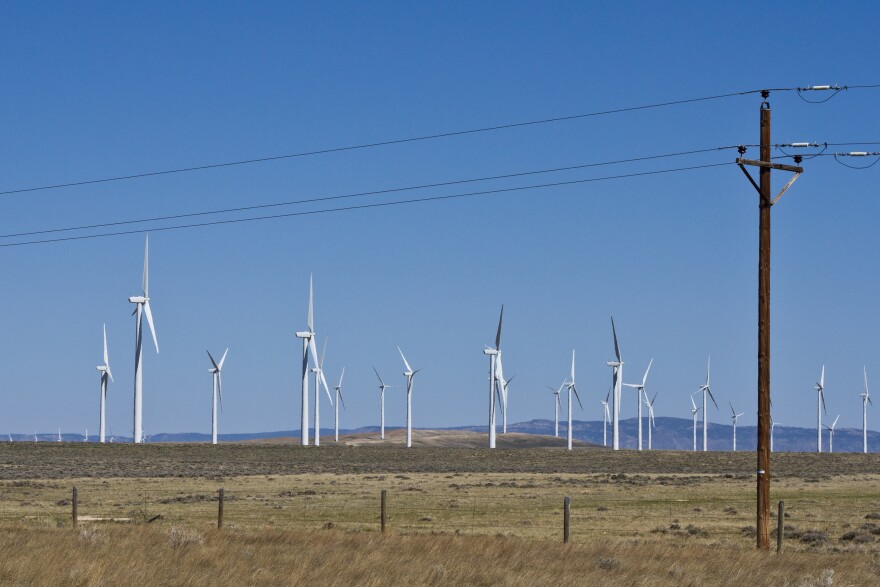Rocky Mountain Power is one of many around the country turning up their investment in wind.
In April of this year, the western utilities company announced new wind projects spanning Utah, Idaho, and Wyoming. They plan to spend around $3.5 billion to add new wind generation to the western electric grid, upgrade turbine technology, and build a much-needed new transmission line, Gateway West, which carries generated energy out of Wyoming.
Rita Meyer, Vice President of Rocky Mountain Power for Wyoming, explained why now is a critical moment to invest in wind.
“We need to have these projects in the ground and fully operational by the end of 2020 to qualify for the production tax credit so that is the driver of doing these projects now,” she says.
The production tax credit, or PTC, is a federal subsidy that provides a couple cents for each kilowatt/hour of wind energy produced. Though it began in 1992, the U.S. Congress renewed a five-year phase-down plan with bipartisan support for the PTC at the end of 2015. It was a part of a spending bill to keep the government from shutting down.
The benefit applies to any wind project started before the end of 2019, though there are ways for projects to qualify for the PTC up to the end of 2020. The tax credit is then counted for ten years after the facility begins service. Meyer said the PTC makes projects like Rocky Mountain Power’s economically viable and it’s not just her company that’s taking advantage.
“I think we’re seeing a real spurt now in activity because of the production tax credit and the idea that it will probably drop off after this final push,” Meyer says.
That spurt in activity could be huge for Wyoming, if the state was eager to attract substantial new wind investment. According to the Department of Energy, Wyoming has the sixth highest wind capacity potential despite sitting at 15th in installed capacity. More companies taking advantage of the PTC, along with several new transmission projects, could allow Wyoming to leap ahead in wind investment.
This past quarter, there were almost 30,000 megawatts of wind capacity under construction or in development nationwide. The American Wind Energy Association says that’s a record. Things may slow down, however, if the GOP tax reform bill goes through as currently written – it trims the wind power PTC.
Still, the current credit is pushing a compressed timeline for wind projects. Jonathan Naughton, Director of the Wind Energy Research Center at the University of Wyoming, says, “It’s going to move development that would’ve occurred over the next ten years, it’s going to move a lot of that over the next four years.”
This window of time could set the stage for where wind energy is produced for years. Many states are positioning themselves to take the lead. Iowa and New Mexico, for example, have state tax benefits for wind energy produced. Texas even funded their own transmission line — ensuring wind developers could actually send their power somewhere.
Naughton said Wyoming could be a wind contender.
“It’s very possible because of the quality of the resource we have, the infrastructure that’s going into place as far as transmission. That would take us from being a minor player… and that would vault us right into the top five.”
But Wyoming is one of the only states in the country that taxes wind production and there’s talk about raising that tax.
“That can make companies nervous.” Naughton says, “so we need to give some stability… provide signs that Wyoming is really welcoming the development. We just need to kind of embrace it and not oppose the wind development, let it happen, right?”
But many others in the state disagree. Cale Case, a Wyoming state senator representing Fremont county, doesn’t think Wyoming should rush headfirst into a big wind commitment before certain issues are settled.
“Our wind resources are going to be here for a long-time. We have to think about developing it carefully. I think it’s a good time to take a deep breath,” Case says.
Wyoming’s economy depends on severance taxes from the state’s extractive industries – coal, natural gas, oil. Though there’s a small generation tax on wind (about $1 per MW/hr), Case says it’s not enough. The tax brings in about $4 million to the state per year, according to Case.
“I think we need to get a permanent sustainable tax to compensate us for what’s happening, this will allow us to have revenue for future generations of Wyoming folks to build schools, roads and take care of the things we need to take care of,” he said.
Arguably, the opportunity to invest in wind won’t be around forever. As technology improves, more states are becoming viable sites for wind farms. While Wyoming has the best wind in the western grid, companies would likely move if the political situation became too burdensome.
Paul Martin, President of Intermountain Wind based out of Denver, said the state of Wyoming has to be more intentional about welcoming wind if it wants to grow the industry. Specifically, he said it should find ways to increase transmission capacity.
“The state could definitely be a leader in the wind industry if it encouraged the industry and invested in transmission to allow for the industry to continue,” Martin says.
Wind proponents point to the industry as a way to bring more jobs and revenue to Wyoming — even if it’s just a piece of the pie in helping to replace the slowly declining coal industry. That’s appealing for a state increasingly looking to diversify its economy away from a fossil fuel dependence. But a wholesale shift in favor of wind is not likely to come quickly enough to take advantage of the current window of opportunity.
Editor’s Note: This story was changed to reflect the fact that Wyoming is not the only state with a wind tax. Minnesota also has one.







